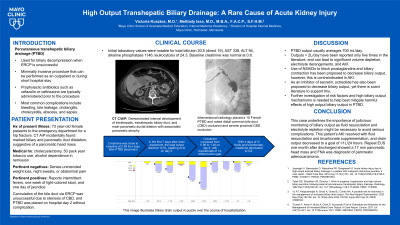Tuesday Poster Session
Category: Biliary/Pancreas
P3601 - High Output Transhepatic Biliary Drainage: A Rare Cause of Acute Kidney Injury
Tuesday, October 29, 2024
10:30 AM - 4:00 PM ET
Location: Exhibit Hall E

Has Audio
- VK
Victoria Kusztos, MD
Mayo Clinic
Rochester, MN
Presenting Author(s)
Victoria Kusztos, MD, Meltiady Issa, MD, MBA
Mayo Clinic, Rochester, MN
Introduction: Percutaneous transhepatic biliary drainage (PTBD) is commonly used for biliary decompression when endoscopic retrograde cholangiopancreatography (ERCP) is unsuccessful. Common complications include bleeding, bile leakage, cholangitis, cholecystitis, abscess, and sepsis. We present a rare case of high biliary output causing prerenal acute kidney injury (AKI) and metabolic acidosis.
Case Description/Methods: A 73-year-old female with history of cholecystectomy, 50 pack year tobacco use, and alcohol dependence in remission was admitted for a hip fracture. CT abdomen incidentally found marked biliary and pancreatic duct dilatation concerning for pancreatic mass versus cholangiocarcinoma. She endorsed intermittent fevers, one week of light-colored stool and one day of jaundice, but no unintended weight loss, night sweats, or abdominal discomfort. Labs were notable for total bilirubin 20.5 (direct 19), AST 338, ALT 94, alkaline phosphatase 1146, WBC 24.3, and baseline creatinine of 0.8. On day 2 of hospitalization, cannulation of the bile duct via ERCP was unsuccessful due to severe stenosis of the common bile duct, and transhepatic biliary drain was placed. In the first 7 days after drain placement, the total output reached 14.6 liters, peaking at 4L on day 5. On day 6, creatinine increased to 1.46, and bicarbonate decreased to 14, with normal anion gap. The biliary cap was closed during the day and uncapped at night. After 4 days of IV fluids and bicarbonate, her creatinine down trended to 0.8 and bicarbonate increased to 25. Once drain output decreased to goal of < 1L/24 hours, she was discharged with plans to internalize the stent via endoscopic ultrasound.
Discussion: Usually, the output of PTBD averages 700 mL/day. Outputs > 2L/day have been reported only five times in the literature, and can lead to significant volume depletion, electrolyte derangements, and AKI. This case underlines the importance of judicious monitoring of biliary output as fluid resuscitation and electrolyte repletion might be necessary to avoid serious complications. Use of NSAIDs to block prostaglandins and biliary contraction has been proposed to decrease biliary output, however, this is contraindicated in AKI. As an inhibitor of secretin, octreotide has also been proposed to decrease biliary output, yet there is scant literature to support this. Further investigation of risk factors and high biliary output mechanisms is needed to help best mitigate its harmful effects.
Disclosures:
Victoria Kusztos, MD, Meltiady Issa, MD, MBA. P3601 - High Output Transhepatic Biliary Drainage: A Rare Cause of Acute Kidney Injury, ACG 2024 Annual Scientific Meeting Abstracts. Philadelphia, PA: American College of Gastroenterology.
Mayo Clinic, Rochester, MN
Introduction: Percutaneous transhepatic biliary drainage (PTBD) is commonly used for biliary decompression when endoscopic retrograde cholangiopancreatography (ERCP) is unsuccessful. Common complications include bleeding, bile leakage, cholangitis, cholecystitis, abscess, and sepsis. We present a rare case of high biliary output causing prerenal acute kidney injury (AKI) and metabolic acidosis.
Case Description/Methods: A 73-year-old female with history of cholecystectomy, 50 pack year tobacco use, and alcohol dependence in remission was admitted for a hip fracture. CT abdomen incidentally found marked biliary and pancreatic duct dilatation concerning for pancreatic mass versus cholangiocarcinoma. She endorsed intermittent fevers, one week of light-colored stool and one day of jaundice, but no unintended weight loss, night sweats, or abdominal discomfort. Labs were notable for total bilirubin 20.5 (direct 19), AST 338, ALT 94, alkaline phosphatase 1146, WBC 24.3, and baseline creatinine of 0.8. On day 2 of hospitalization, cannulation of the bile duct via ERCP was unsuccessful due to severe stenosis of the common bile duct, and transhepatic biliary drain was placed. In the first 7 days after drain placement, the total output reached 14.6 liters, peaking at 4L on day 5. On day 6, creatinine increased to 1.46, and bicarbonate decreased to 14, with normal anion gap. The biliary cap was closed during the day and uncapped at night. After 4 days of IV fluids and bicarbonate, her creatinine down trended to 0.8 and bicarbonate increased to 25. Once drain output decreased to goal of < 1L/24 hours, she was discharged with plans to internalize the stent via endoscopic ultrasound.
Discussion: Usually, the output of PTBD averages 700 mL/day. Outputs > 2L/day have been reported only five times in the literature, and can lead to significant volume depletion, electrolyte derangements, and AKI. This case underlines the importance of judicious monitoring of biliary output as fluid resuscitation and electrolyte repletion might be necessary to avoid serious complications. Use of NSAIDs to block prostaglandins and biliary contraction has been proposed to decrease biliary output, however, this is contraindicated in AKI. As an inhibitor of secretin, octreotide has also been proposed to decrease biliary output, yet there is scant literature to support this. Further investigation of risk factors and high biliary output mechanisms is needed to help best mitigate its harmful effects.
Disclosures:
Victoria Kusztos indicated no relevant financial relationships.
Meltiady Issa indicated no relevant financial relationships.
Victoria Kusztos, MD, Meltiady Issa, MD, MBA. P3601 - High Output Transhepatic Biliary Drainage: A Rare Cause of Acute Kidney Injury, ACG 2024 Annual Scientific Meeting Abstracts. Philadelphia, PA: American College of Gastroenterology.
